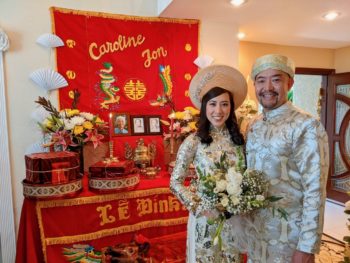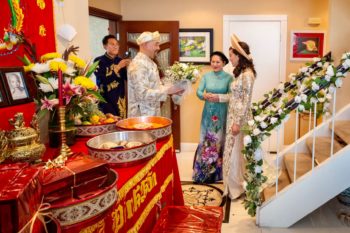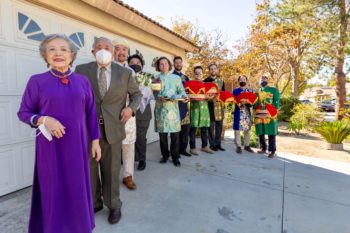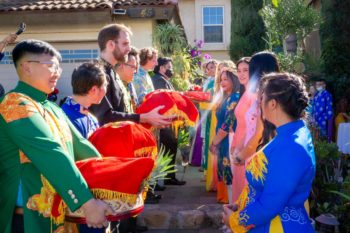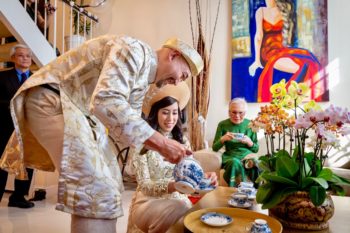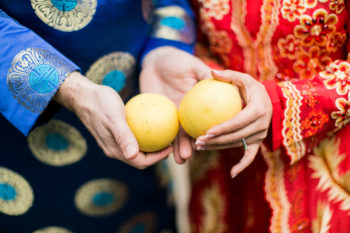Vietnamese Marriage Customs (2) – Lễ Đính Hôn Posted by Kandle Dart on Dec 6, 2021 in Culture
Lễ đính hôn or Lễ hỏi is the engagement ceremony.
Whether it happens a year before the wedding ceremony, a few months before, or even one day before the wedding, it is an important custom in the marriage process that nobody wants to skip. This is not just a matter between the fiancé and fiancée. It involves the formal engagement and participation of both families.
To the girl’s family, this ceremony is even more important than the wedding ceremony because this event marks the official bond between the two families, and announces the wedding plan. The ceremony is performed at the fiancé’s home. Therefore, the girl’s parents host the event. The house would be decorated in festive colors. It is a chance for the girls’ parents to showcase the hospitality to both families and their relatives.
ANCESTOR WORSHIP TABLE
The ancestor worship table would shine with at least these essential polished brass objects below the pictures of the deceased maternal and paternal ancestors of the fiancé:
- Một cặp bình hoa (a pair of flower vases)
- Một cặp chân nến (A pair of candle holders)
- Một lư hương (an incense burner censer)
- Một bình nhang (an incense stick pot holder)
This is an important place where the young couple light the candles, the incense sticks, and bow to pay respect to the ancestors together.
REPRESENTATIVE PERSON
Before the event, each family would choose their respective người đại diện (representative). Usually, it’s an important person with high ranking in the family or a relative who is eloquent and has the ability to control the ceremonial’s flow. At lễ đính hôn, người đại diện nhà gái (the girl’s family) will đại diện (represent) nhà gái to welcome nhà trai (boy’s family), to announce the agenda, to accept the gifts, to introduce the girl and the important members of the family, and to decide each step of the ceremony.
Người đại diện nhà trai would lead the entourage of nhà trai to enter the house of nhà gái, to introduce members of nhà trai, to coordinate and facilitate with người đại diện nhà gái, and to complete the engagement ceremony.
ENGAGEMENT GIFTS
Nhà trai will have to prepare the gifts to bring to nhà gái for the engagement ceremony. The gift portions, per nhà gái’s request, were discussed before the engagement. Gifts are placed in round tin can boxes or trays, covered in red cloth, and always accumulated in odd numbers. Usually in the number of 3, 5 ,7, 9, or 11, depending on nhà trai’s wealth status. The standard traditional gifts include:
- Trầu cau (betel leaves and areca nuts)
- Bánh phu thê (husband & wife cakes)
- Trà (tea)
- Rượu (wine)
- Heo quay (roasted pig)
- Hoa quả (fruits)
- Xôi gấc (red sticky rice) or cốm xanh (green sticky rice’s flake )
The gift bearers from nhà trai are all men (ideally single). They line up at least 25 yards away then start walking to the house of nhà gái at a pre-arranged, auspicious hour (usually between 11AM-1PM). At the entrance, a matching number of girls (ideally single) from nhà gái line up to receive the gifts from nhà trai.
A portion of these gifts will later be returned back to nhà trai. It’s called lại quả. The rest will be distributed to the high ranking relatives of nhà gái.
AFTER THE CEREMONY
After all the rituals such as bowing to the ancestor table, serving tea to the grandparents, parents, or the highest-ranking elders of both sides is complete. It’s time for celebration with lots of food, casual chat, and entertainment. People can start to congratulate the soon-to-be married couple, pictures are taken with friends and relatives, the cake is cut, and everyone chows down on all the goodies that nhà gái provides.
ENGAGEMENT OUTFITS
Ladies wear áo dài, the Vietnamese traditional dress. Men either also are in áo dài or suits. The fiancé’s outfit is usually red, pink, or some other vivid colors. The fiancée outfit is usually a striking blue.

Build vocabulary, practice pronunciation, and more with Transparent Language Online. Available anytime, anywhere, on any device.



